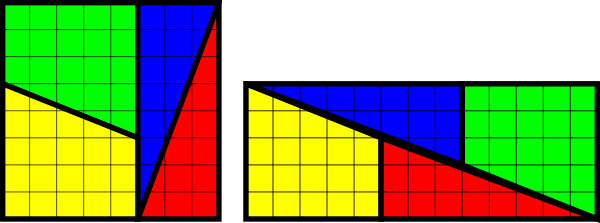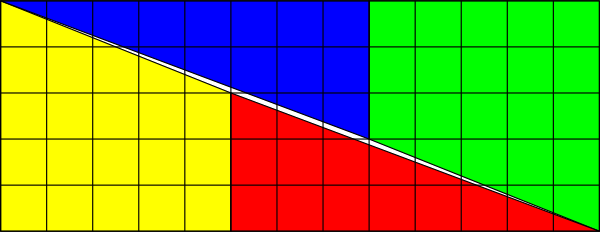A week ago, Brent at The Math Less Traveled introduced me to a problem that he called An Area Paradox.

Examine the two figures above. They are composed of exactly the same set of shapes (a red and blue triangle, and a green and yellow trapezoid). However, the figure on the right is a square measuring 8×8=64 square units, while the figure on the left is a rectangle measuring 5×13=65 square units. How is this possible?
The trick is that the heavy black lines obscure what is going on. The pieces don’t actually fit together in the way shown—there is a little bit of a gap. If we make the lines narrower, and blow up the figure a little, it becomes clear what is happening.

In the original figure, the narrow white gap between the pieces was covered by heavy black lines, which made it appear that the pieces fit together perfectly. It is now clear that this is not the case. One commenter noted that 5 and 13 (the dimensions of the second figure), and 8 (the dimension of the square) are all Fibonacci numbers.
Specifically, we have the following relation: 5 is the fifth Fibonacci number, 8 the sixth, and 13 the seventh. When we multiply 5 and 13, we get 65, which is one more than the square of 8. It seems that there may be a relationship between the squares of Fibonacci numbers, and the product of the previous and next Fibonacci numbers.
To see if we can figure out what this relationship might be, it makes sense to first see if a pattern exists. Before we get to that, I am going to introduce just a bit of notation, which should make life a little easier. We are going to call the nth Fibonacci number \(F_n\), and we are going to start counting at \(F_0\). The Fibonacci numbers are then \(F_0 = 1, F_1 = 1, F_2 = 2, F_3 = 3, F_4 = 5, \ldots\) and so on. The general pattern is that each new Fibonacci number is the sum of the previous two. That is, \(F_{n+1} = F_n+F_{n-1}\).
Armed with this notation, we can start looking for patterns. The original relationship was that \(8^2 = 5\cdot 13 – 1\), which is equivalent to \(F_5 = F_4F_6 – 1\). Let’s see if there really is a pattern like this in the Fibonacci numbers:
\(F_1^2 = 1\) and \(F_0F_2 = 2\quad\Longrightarrow\quad F_1^2 = F_0F_2-1\)
\(F_2^2 = 4\) and \(F_1F_3 = 3\quad\Longrightarrow\quad F_2^2 = F_1F_3+1\)
\(F_3^2 = 9\) and \(F_2F_4 = 10\quad\Longrightarrow\quad F_3^2 = F_2F_4-1\)
\(F_4^2 = 25\) and \(F_3F_5 = 24\quad\Longrightarrow\quad F_4^2 = F_3F_5+1\)
Well, this isn’t exactly the pattern that we were hoping for—the sign on the last term keeps changing around on us—but it looks like there is at least some pattern that we can work with. It seems that the squares of Fibonacci numbers may be associated with the adjacent numbers by the identity \(F_n^2 = F_{n-1}F_{n+1}\pm 1\).
That plus or minus symbol causes a little bit of heartache, so we should probably try to figure out what the pattern is. It seems that it switches every time we increase n by one. If we are clever, we note that \((-1)^n\) is -1 when n is odd, and 1 when n is even. Hence the relationship that we noticed above might be written as
\(F_n^2 = F_{n-1}F_{n+1} + (-1)^n.\)
Of course, while this identity looks good on paper, we aren’t done until we can prove it. We are going to use a technique called proof by induction. Proof by induction has two steps: first, we show that the identity is true when \(n=1\). Once we have done that, we show that if we assume that it is true for some k, then it has to be true for \(k+1\). So, let’s do it!
First, note that \(F_1^2 = F_0F_2 – 1\), as we showed above. This is exactly what we want. For induction, assume that \(F_k^2 = F_{k-1}F_{k+1} + (-1)^k\) (this is called the “induction hypothesis”). We now want to show that it follows from our assumption that \(F_{k+1}^2 = F_{k}F_{k+1}+(-1)^{k+1}\). If we start with the right-hand side of that equation, we would like to play around until we get the left-hand side. Without commentary, this can be done as follows:
\((1)\quad F_{k}F_{k+1}+(-1)^{k+1}\)
\((2)\quad\quad\quad = F_{k}\left(F_{k}+F_{k-1}\right)+(-1)^{k+1}\)
\((3)\quad\quad\quad = F_{k}^2+F_{k}F_{k-1}+(-1)^{k+1}\)
\((4)\quad\quad\quad = F_{k-1}F_{k+1} + (-1)^k + F_{k}F_{k-1}+(-1)^{k+1}\)
\((5)\quad\quad\quad = F_{k+1}\left(F_{k-1}+F_{k}\right)\)
\((6)\quad\quad\quad = F_{k+1}^2\),
which is exactly what we were hoping to get. A couple of the steps are perhaps a little non-obvious, so a bit of explanation: to get from line (1) to line (2), we used the definition of a Fibonacci number. We did the same thing to get from line (5) to (6). From line (3) to (4), we used the induction hypothesis. That is, we used the thing that we assumed was true. Finally, to get from (4) to (5), we factored an \(F_{k+1}\) out of each term, and noted that \((-1)^k + (-1)^{k+1}\) is the same as \((-1)+(1) = 0\) (If k is even, then we have \((1)+(-1) = 0\); and if k is odd, we have \((-1)+(1) = 0\). Either way, it’s zero.)
Thus we have proved that \(F_n^2 = F_{n-1}F_{n+1} + (-1)^n.\) It turns out that this result has been known for more than 400 years, and even has a name (Cassini’s Identity), but it is always nice to know that we can work things out for ourselves.
So what does this have to do with the original set of figures? Basically, we could construct a square with side length equal to any Fibonacci number. Then, by dividing that square into triangles and trapezoids with dimensions related to the previous two Fibonacci numbers, we can move things around to create a rectangle that is one unit larger, but where that one extra unit can be hidden along the diagonal with heavy lines. The particular dimensions chosen in the original problem are particularly nice, however: they are small enough that they can be easily counted and seen, yet large enough that it doesn’t take a particularly heavy line to hid the gap.
As a final note, consider what happens as we take higher and higher Fibonacci numbers. As we have already seen, the ratio of larger and larger Fibonacci numbers approaches the golden ratio. As we take larger and larger Fibonacci numbers, the rectangle formed by the green and yellow trapezoids will approach a golden rectangle. Moreover, the rectangle formed by all four shapes will be similar (same proportions, different sizes) to the rectangle formed by only the red and blue triangles: the ratio of the side lengths of both will be \(1:(1+\varphi)\), where \(\varphi\) is the golden ratio.
